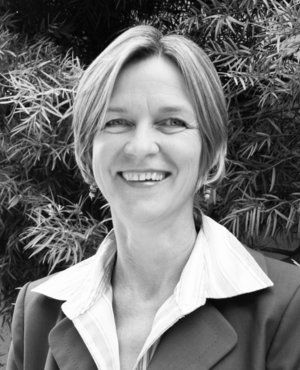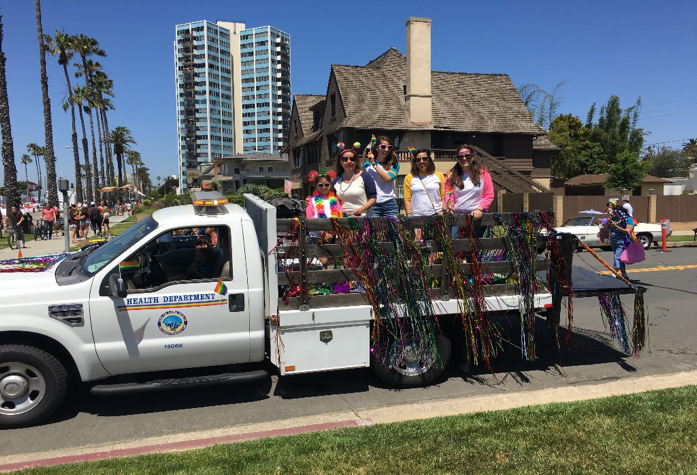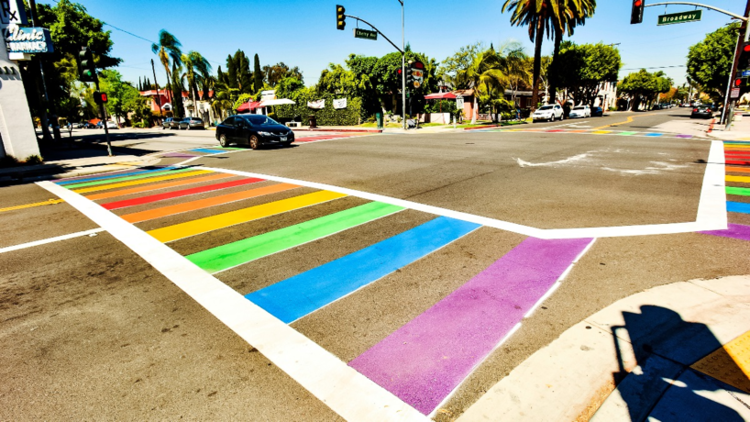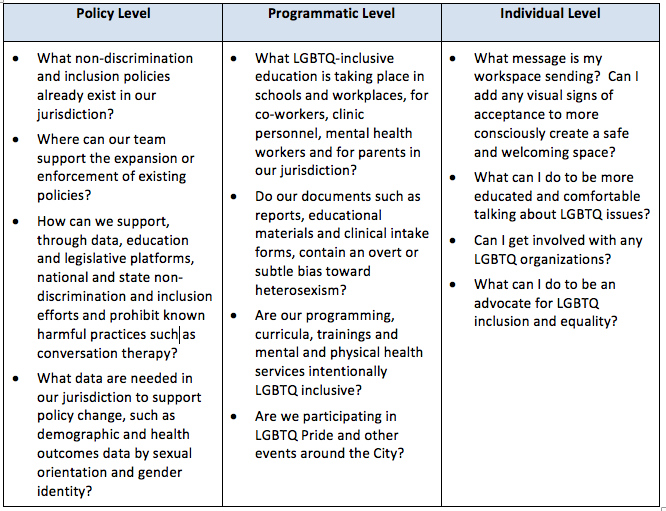LGBTQ Pride and Public Health
June 2018
Ginger Lee, MPH, Bureau Manager, Collective Impact & Operations,
Long Beach Department of Health and Human Services

June is LGBTQ Pride month. Pride is a time when lesbian, gay, bisexual, transgender, queer and questioning people join together to further strengthen community by celebrating joyously, with parades and other events. Pride is also a time when the LGBTQ community remembers its history. And for public health professionals, Pride is a time to reflect on what we can do to address social conditions that negatively affect the health of LGBT people, and to strengthen conditions that support health within our LGBTQ communities.
The first Pride parade took place in the streets of New York in 1970 to mark the one year anniversary of the Stonewall riots. The riots were a reaction to a police raid on the Stonewall Inn in Manhattan. Knowing this helps to clarify why Pride is a time when the LGBTQ community revels in simple privileges such being highly visible yet safe, claiming one’s own identity, shedding the burden of rejection, and enjoying the loving embrace of “family.”

Public health professionals know much more now than we did in 1970 about the inextricable link between social health, mental health and physical health. A paradigm shift is nearly complete, away from a sole focus on individual behavior, toward a population health focus rooted in a stronger understanding of how social conditions and trauma directly affect health.
Pride serves an important purpose in supporting the health of the LGBTQ community, since health disparities often can be attributed to social conditions affecting groups. The LGBTQ community has endured systemic and legally sanctioned discrimination, shaming by institutions and systems, shunning by families of origin, the HIV epidemic, and being targeted for brutality and violence because of who LGBTQ people love or how they express their gender. Because many LGBTQ people are also people of color, stressors and conditions known to negatively affect health are often multiplied.
Pride is a time when the LGBTQ community comes together to remind one another and the wider community of all their beauty, diversity and strength. It is a time when, surrounded by like-minded people, the LGBTQ community can relax, be affirmed, and celebrate victories.
There are plenty of victories to celebrate. Same sex marriage is legal. A major form of societal rejection, lack of acceptance into the institution of marriage, has been removed by law. Equal tax treatment and other benefits are now available for any legally married couple. LGBTQ people can adopt and serve as foster parents. Gender neutral restrooms are being written into law, and many universities and cities already have adopted gender neutral restrooms. While there is no federal anti-discrimination law that provides explicit protections on the basis of sexual orientation or gender identity, as of this June, 18 states and the District of Columbia have adopted anti-discrimination laws that included protections for transgender people.[1]
And yet in March 2018, the president signed a transgender military ban. Just this month, June 2018, a divided Supreme Court absolved a Colorado baker of discrimination for refusing to create a wedding cake for a same-sex couple.
The Human Rights Campaign has just released its 2018 LGBTQ Youth Report. The findings from more than 12,000 LGBTQ youth ages 13-17 from all 50 states and Washington D.C. are chilling. Seventy four percent said they do not always feel safe in the classroom; 73% have experienced verbal threats, and 11% have been sexually attacked or raped because of their actual or assumed LGBTQ identity. Seventy seven percent reported feeling depressed or down over the past week, with more than 70% reporting feelings of worthlessness and hopelessness in the past week. LGBTQ youth of color and transgender teenagers experience unique challenges and elevated stress. Only 11% of youth of color surveyed believe their racial or ethnic group is regarded positively in the U.S.[2]
LGBTQ youth are rejected from their homes at higher rates than their non-LGBTQ peers. As a result, they are overrepresented in the youth homeless population, foster care and juvenile justice systems. The Williams Institute reports the incarceration rate for LGB people is three times the rate of the general population.[3] While LGBTQ youth make up about 5 to 10% of the overall youth population, about 40% of homeless youth are LGBTQ.[4]
LGBTQ youth are also at higher risk of suicide. LGBTQ youth are almost five times as likely to have attempted suicide compared to heterosexual youth.[5]
LGBTQ older adults are more vulnerable as well. Since many did not have children, they can lack that level of social support. Older adults can be more apprehensive about how they will be treated by the health care system or in senior care facilities[6], which can cause some people to avoid or delay care. Older women partners have experienced twice the effect of the gender pay gap than mixed gender couples.
The National Center for Transgender Equality reports that the transgender community experiences rates of unemployment at three to four-times the rate of the general population.[7] The transgender community can also be apprehensive about seeking care in medical settings, potentially driven by previous experiences with care that was not culturally competent.
While studies can illuminate disparities in general, specific data at more local levels often do not exist.
Long Beach, California celebrates Pride with a flair, and there are many other signs that Long Beach is a welcoming and affirming city. The City has invested in creating visible signs of welcome, such as painted rainbow crosswalks. Long Beach benefits from a thriving LGBTQ Center that offers services related to community building and culture, physical and mental wellness, and legal assistance for people of all ages. California State University Long Beach offers a minor in Queer Studies. Long Beach is home to several popular LGBTQ establishments, and LGBTQ specific events and entertainment are readily available as points of connection. Public health messages and programming are often woven into this rich LGBTQ fabric.

There has been a significant cultural shift toward greater support and acceptance of LGBTQ people. Even so, there is still work to do. Public health professionals can act to protect LGBTQ youth and to make our services, workplaces, schools and jurisdictions more welcoming for LGBTQ people of all ages. Looking at our policies, programs and our own individual workspaces through an LGBTQ-friendly lens can help us identify important opportunities to create changes that support health and wellness. The table below offers questions to help guide this approach.
Questions for Health Departments

Pride is a time of celebration. Pride is a time to remember the progress we’ve made toward equality and inclusion, and, at the same time, to acknowledge that this progress has come at a high cost. Public health professionals and policy makers are in a position to make the changes needed to improve the health and wellness of the LGBTQ community. Regardless of whether we are in a policy making role, we in public health have an especially crucial role to play in promoting inclusiveness and equality for the LGBTQ community, and for the sake of the broader communities we serve.
[1] https://ballotpedia.org/Transgender_bathroom_access_laws_in_the_United_States.
[2] 2018 LGBTQ Youth Report, Human Rights Campaign.
[3] LGBQ Youth Disproportionately Incarcerated in the U.S. Juvenile Justice System. Wilson, B.D.M; Jordan, S.P.; Meyer, I.H.; Flores, A.R., Stemple, J.D.; Herman, J.L. Williams Institute. April 2017.
[4] https://truecolorsfund.org/our-issue/
[5] CDC (2016). Sexual Identity, Sex of Sexual Contacts, and Health-Risk Behaviors Among Students in Grades 9-12: Youth Risk Behavioral Surveillance. Atlanta, GA: U.S. Department of Health and Human Services.
[6] BGT Aging: A Review of Research Findings, Needs, and Policy Implications. Choi, S.K; Meyer, I.H. Williams Institute. August 2016.
[7] James, S. E., Herman, J. L., Rankin, S., Keisling, M., Mottet, L., & Anafi, M. (2016). The Report of the 2015 U.S. Transgender Survey. Washington, DC: National Center for Transgender Equality.